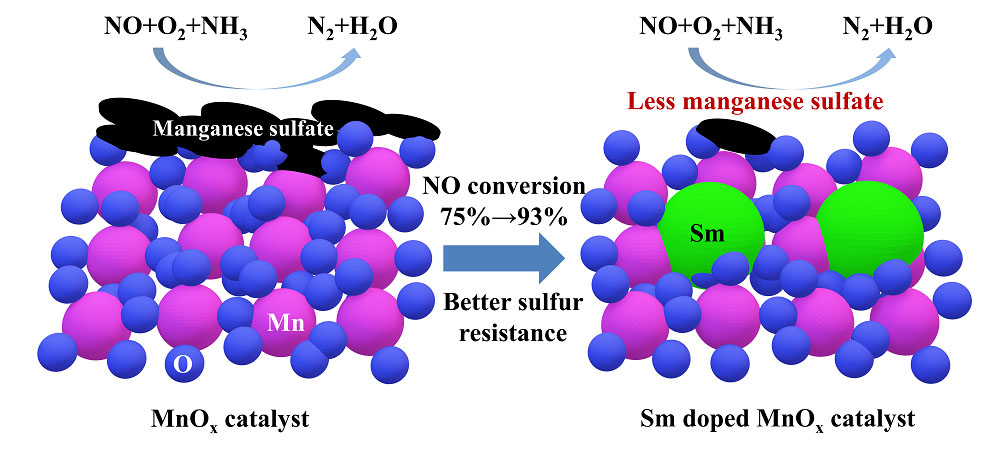Sulfur ammonium salts and manganese sulfate decompose at specific temperatures. Therefore, thermal analysis of MnO
x and 0.10Sm–Mn catalysts before and after poisoning is conducted to further determine whether the catalyst surface would generate sulfur ammonium salts and manganese sulfate after being poisoned by SO
2. According to the TG-DTG (derivative thermogravimetry) curves in Fig.3, the weight loss of MnO
x sample before poisoning is primarily categorized into the following four stages: sample removal of adsorbed water and bound water (< 200 °C), decomposition of residual carbonate (approximately 541 °C), conversion of MnO
2 and Mn
2O
3 (approximately 585 °C), and conversion of Mn
2O
3 and Mn
3O
4 (approximately 730 °C). For the MnO
x after poisoning, new weight loss peaks appear at approximately 420, 646, and 800 °C. Among them, the peaks at approximately 420 and 800 °C are assigned to the decomposition of ammonium bisulfate and manganese sulfate, respectively [
5,
34]. According to Fig.3, there is only 0.66 wt % weight loss of ammonium bisulfate and 2.64 wt % weight loss of manganese sulfate. As for the new peak near 646 °C, Sun et al. [
31] discovered the same phenomenon in the SO
2 poisoning inactivation study of MnO
x/TiO
2, which the phase transition of manganese oxide may cause. The TG of 0.10Sm–Mn samples before poisoning can be divided into the following three stages: the weight loss process of water (< 300 °C), decomposition of residual carbonate as well as the transformation of MnO
2→Mn
2O
3 (440–680 °C), and Mn
2O
3→Mn
3O
4 (700–800 °C) [
6]. After poisoning, new weight loss peaks appear at 195 and 385 °C, which are the decomposition of ammonium sulfate and ammonium bisulfate, respectively, and the weight loss of ammonium sulfate is 2.5 wt %. The weight loss of ammonium sulfate is 1.06 wt %. Notably, the weight loss of MnO
x increased significantly from 700 to 840 °C after poisoning (approximately 2.64 wt %), whereas the weight loss of 0.10Sm–Mn changes little after 700 °C. Therefore, the content of manganese sulfate of 0.10Sm–Mn is higher than MnO
x catalyst after poisoning. Although the 0.10Sm–Mn catalyst will create more ammonium sulfate, this compound is rapidly broken down, does not deplete the manganese’s active sites, and does not significantly reduce the catalyst’s activity.
















